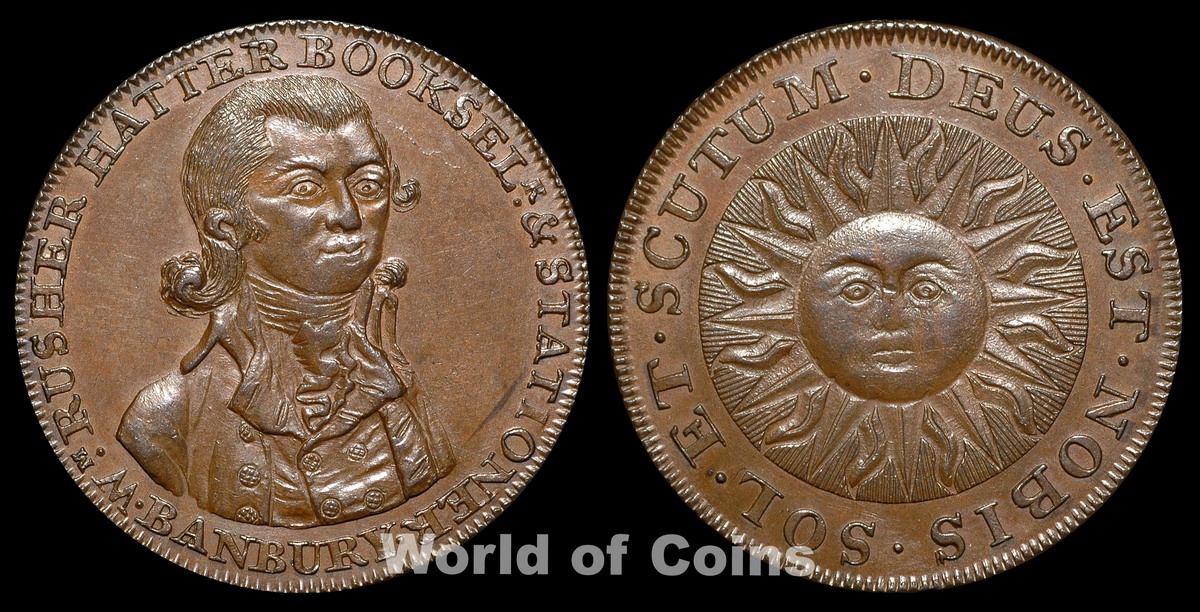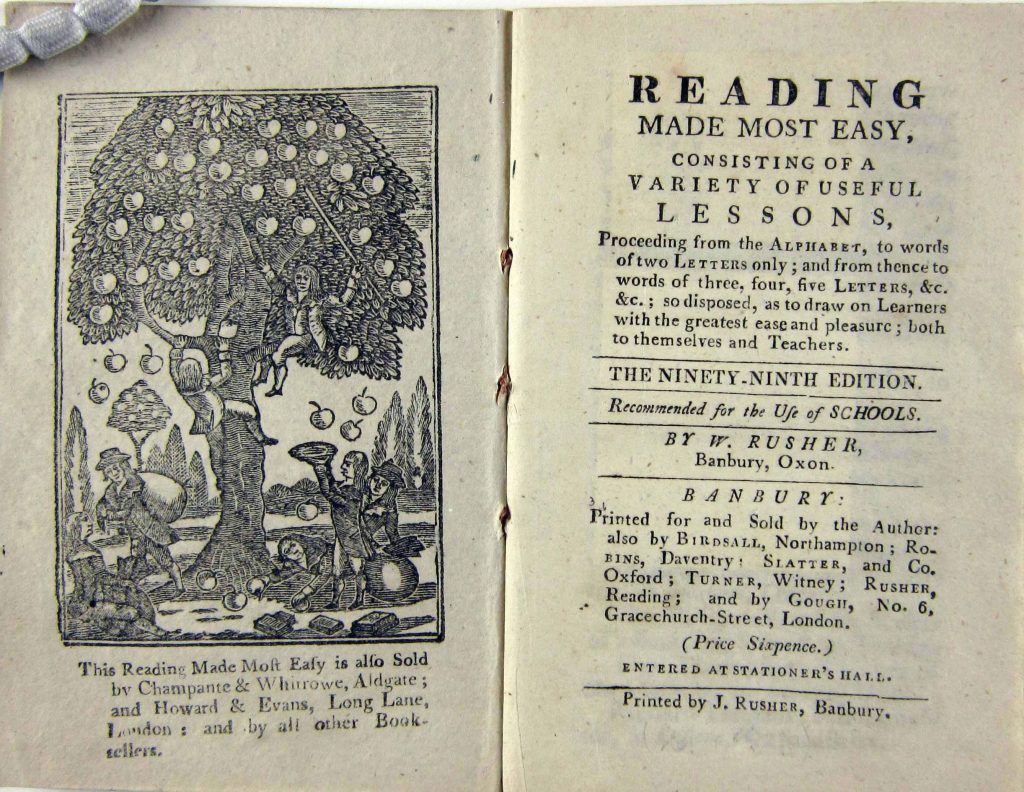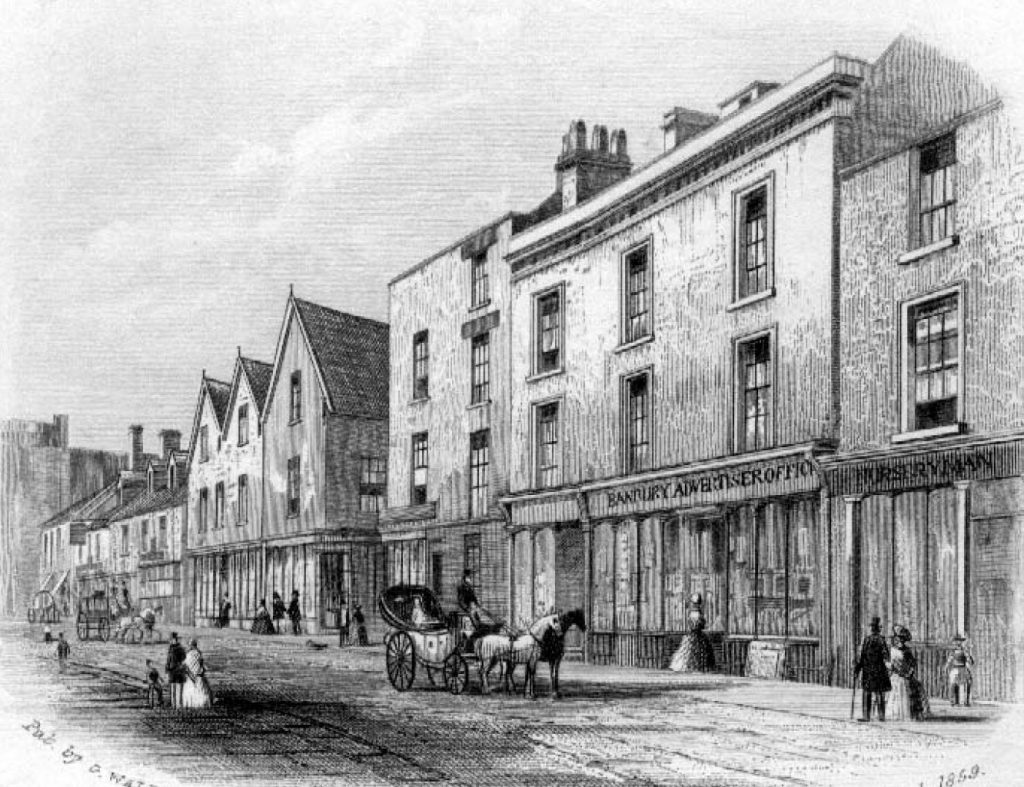
Online collections
monedastodas.com
All collections » Tokens » Banbury Halfpenny
The obverse features a bust of William Ruscher in costume. Circle legend: “WM. RUSHER HATTER BOOKSELL.R & STATIONER. BANBURY” (William Rusher hatter, publisher and bookseller in Banbury).
 Oxfordshire
Banbury D&H1
Oxfordshire
Banbury D&H1William Rusher (b. c. 1759) was the second son of John Rusher Sr. (b. 1720-25), a yeoman of Charlbury. In 1783, William married Mary Golby at Banbury Church, where he was recorded as schoolmaster at the Bluecoat Charitable School. In 1785, William had his own bookshop, as evidenced by numerous advertisements in the Oxford weekly Jackson's Oxford Journal (JOJ). One of the announcements for November 1794 describes the scale of William's business in some detail: “All kinds of books and stationery, men's and children's hats, gold rings, silverware, plated buckles, spectacles, etc. sold cheaply at William Rusher's (the late Mr. White's shop) in Market Place, Banbury". In the same magazine for December 1794, there was an advertisement for the sale of books only, perhaps the wide range of goods in mid-November was the result of the recent acquisition of the late Mr. White's shop.

According to the ads, at this time he published his own book for children called Reading made easy , sold at 6d a piece, which had been in demand for quite a long time, and was undoubtedly produced especially for the school.
In addition to selling books, William handled fees and taxes, which meant he had a certain status in the city, and was also a source of a small additional income. Many documents, such as leases or marriage certificates, had to be either pre-printed or stamped at the time of drafting. The fees were a source of tax revenue for the government and, being an accredited agent on the subject, William Rusher was authorized to deduct a portion of this money for his services.
 High
Street, Banbury, in 1859 (engraved by G.Walford)
High
Street, Banbury, in 1859 (engraved by G.Walford)
In 1795 William Rusher started Rusher's
Banbury Lists (1795-1906). The first issue was printed on just one
side of the sheet: it listed the city authorities of the then sparsely populated
town of Neutrop. But the very next year, the publication turned
into a booklet, which became quite popular.
The first leaf of 1795 was distributed
free of charge to all customers in William Rusher's shop in Market Place,
Banbury, as reported in JOJ, December 6, 1794. Publication of the
Banbury Lists continued until 1906. For the past few years, its
publisher has been William Potts, who bought the rights to issue from Jane Eliza
Rusher in 1877, who inherited it from her father, John Golby Rusher. In
the same announcement, William announced his intention of converting a room or
two into a reading room and a major expansion of his circulating library
library.
As follows from the edge inscription
(PAYABLE AT BANBURY OXFORD OR READING), William had extensive trade relations
with various areas. The fact that William is listed as a hatter
dates the token to around 1794 or 1795, as there is no evidence that William
sold hats before becoming owner of the late Mr. White's shop in late 1794, or
continued to trade hats later. At Oxford his business partner was
the printer Richard Slatter, and at Reading his younger brother James Rusher.
William Rusher retired around 1822, when
he was about 63 years old, handing over the management of the bookshop to his
son Thomas Golby Rusher, and in 1832 another of William's sons, John Golby
Rusher, took charge of the Rusher's Directories (1832-1906). ), and in 1834
became mayor of Banbury.
As a pensioner, William lived in a
comfortable house on top of Overtop Hill with his wife and daughter Mary (b.
1795). In 1824 Mary married a prominent grocer, Philip Davies of
Reading, and in early 1829 William and his wife moved to Battle Place, Reading,
to be closer to their daughter.
William died on March 13, 1849, and was
buried at Reading, leaving behind a legacy of tracts of land and copyhold
properties leased out in Banbury and Marston.
The reverse side shows a fragment of
the coat of arms of the city of Banbury - the sun shining with golden rays on an
azure background. Circular legend, the motto of the city of Banderi:
“DEUS. EST. NOBIS. SOL. ET. SCUTUM”
(The Lord is the sun and shield for us).
Banbury, partly in Oxfordshire and partly
in Northamptonshire, was founded by Queen Mary I 1516–1558 and its coat of arms
was approved in 1584.
Excavations for the construction of an
office building on Hennef Way in 2002 unearthed the remains of an Iron Age
British settlement with round buildings built around 200 BC, as well as numerous
remains of pottery. Later, in Wickham Park, the remains of a Roman
villa were discovered.
At the end of the 5th century, the area
was settled by the Saxons. According to the Anglo-Saxon chronicles,
in 556 King Cynric and his son Cevlin (Cynric and Ceawlin) defeated the Britons
at Beranburg (modern Banbury). By the middle of the 6th century,
the city had become the center of an Anglo-Saxon settlement. During
this period, the city developed under the influence of the Danish invasion,
starting from the end of the 6th century.
In the Domesday Book, the city was rated
at 50 guides * and belonged to the Diocese of Lincoln. The location
at the junction of two ancient roads: Salt Way, used to transport salt and
Bandery Lane for the sheep wool trade, ensured the prosperity of Banbury in the
Middle Ages.
Banbury Castle was built in 1135 by
Bishop Alexander of Lincoln and was used by King Stephen during the civil war of
1135-1154. Having survived several sieges during the English
Revolution (English Civil War), the castle was completely destroyed in 1648. Later,
the stones from the castle were used to build houses in the city.
The opening of the Oxford Canal from
Hawkesbury to Banbury on 30 March 1778 gave the city a cheap and reliable supply
of coal from Warwickshire. In 1787, a southward expansion of the
canal began, opening on 1 January 1790 at Oxford. The canal's main
construction yard was today's Tooley's Boatyard.
Edge inscription: “PAYABLE AT BANBURY
OXFORD OR READING +”.
Engraver: Arnold, producer: Latvich. 5
cwts released.
Note:
Jackson's Oxford Journal is
an Oxford newspaper founded by Oxford University publisher William Jackson. The
first issue appeared on May 5, 1753, and the last on December 29, 1900.
Hyde (eng. hide, Anglo-Saxon: hϊd or
hiwisc; lat. carrucate) is
a unit of land in Anglo-Saxon Britain (with the exception of Kent and the
territories of Danish law). One guide was the amount of cultivated
land sufficient to support one family of a free peasant (curl).